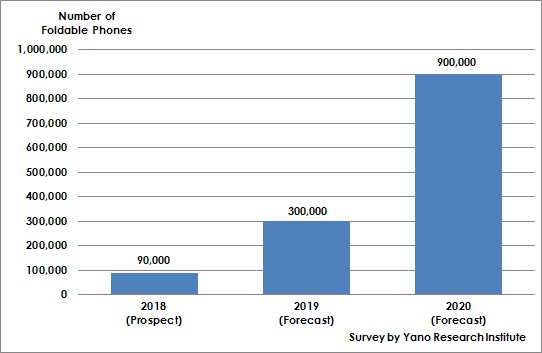No.1858
Global Foldable Smartphone Market: Key Research Findings 2018
Global Foldable Smartphone Market: Key Research Findings 2018
Yano Research Institute (the President, Takashi Mizukoshi) has surveyed the flexible display material market within and outside the country for 2018 and has clarified the trend by segment, by market player, and future outlook, together with forecast of global market size.

Market Overview
flexible OLED using Polyimide (PI) substrate for flexible and curved-surface smartphones has been increasingly introduced. Also, with transparent PI films with their surface hardness around 5H, curvature radius on bending around R1 to 2 having been developed, foldable terminals to become real seem to be anytime soon. Some in the industry even say that they are sure of Samsung Electronics to commercially launch foldable smartphones within 2018. On the other hand, however, even if foldable smartphones are actually released within 2018, a certain period of time may be needed for the market to establish. It is unavoidable for such foldable smartphones to face problems such as deterioration of displays, disconnection of sensors, whitening of or crack in the surface covers, in the course of repeated folding and opening of the terminals. According to our research, the stable demand of foldable terminals is projected to be established in 2020 and beyond.
The market size of foldable smartphones, based on shipment volume at makers, is forecasted to be only around 90,000 units by 2018, but is projected to expand to 300,000 units by 2019, and 900,000 by 2020. Though the market may take time to establish, once the products are sold, new demands are very likely to be generated though they are still the mystery during the development phase, and therefore, the challenges for material makers in development of products are expected to become clearer. Material makers are required to be able to create the films with satisfactory performance and quality that match the demand of their users, i.e., flexible display makers and manufacturers of assembled products (for end users), and be able to enhance the technology to improve such products even further.
Noteworthy Topics
Flexible AMOLED Screens
Because flexible OLED screens using a substrate based on polyimides (PI) do not use rigid glass, they contribute to improve designs of smartphones by enabling curved surface and displaying in full screen, which is the reason why they are increasingly introduced as flexible displays. In addition, following the trends of Apple and SEC which lead the smartphone market, increasing number of Chinese smartphone makers is considering development of new models embedding flexible OLED screens. The global market of flexible OLED screens for smartphones in 2018, based on shipment volume at manufacturers, is projected to make another great stride since last year to attain 260 million screens, 187.1% on year-to-year basis.
In such a status where the demand of flexible OLED screens primarily for smartphones has been expanding, Samsung Display Co., Ltd and LG Display Co., Ltd have enhanced the production line of such screens, and not a few makers trying to enter AMOLED screen market aim to mass produce flexible OLED screens. Therefore, flexible OLED screens are expected to expand their introduction to smartphones for the future, with the market size to attain about 491 million screens by 2019, exceeding the size of rigid OLED screens for smartphones.
Future Outlook
Although curved-surface smartphones use flexible OLED using Polyimide (PI) substrate, if all such smartphones need is a flexible or foldable display, they can also use super-thin glass (about 50-micrometre thickness) that can curve. However, OLED with a PI-based film substrate is used because the film instead of glass is inevitable for the users' (i.e., flexible display makers’) side. If so, what the display material makers are needed is not the replacement of glass but the films that can be chosen among various films.
In order for display material makers to be chosen by flexible display makers, they need to develop and propose "useful materials". Such usefulness not only indicates performance and quality but also price and easy procurement. Therefore, flexible display material makers are likely to be required to establish a system that enables to supply those films with their quality and performance satisfactory to meet what users' needs, at adequate price at any time anywhere.
Research Outline
2.Research Object: Makers of flexible display materials (polyimide (PI) films, high-barrier films and etc.)
3.Research Methogology: Face-to-face interviews by the expert researchers, and literature research
What is the Global Flexible Smartphone Market?
The global flexible smartphone market in this research indicates the market calculated by the shipment volume at makers of foldable smartphones. Flexible display materials in this research indicate highly transparent/highly-temperature-resistant films, and high barrier films used in substrates and surface of flexible displays, i.e., curved-surface, foldable, and rollable displays.
Products and Services in the Market
Polyimide (PI) films, Polyimide varnish, high barrier films, highly-transparent films, highly-hard films
Published Report
Contact Us
The copyright and all other rights pertaining to this report belong to Yano Research Institute.
Please contact our PR team when quoting the report contents for the purpose other than media coverage.
Depending on the purpose of using our report, we may ask you to present your sentences for confirmation beforehand.